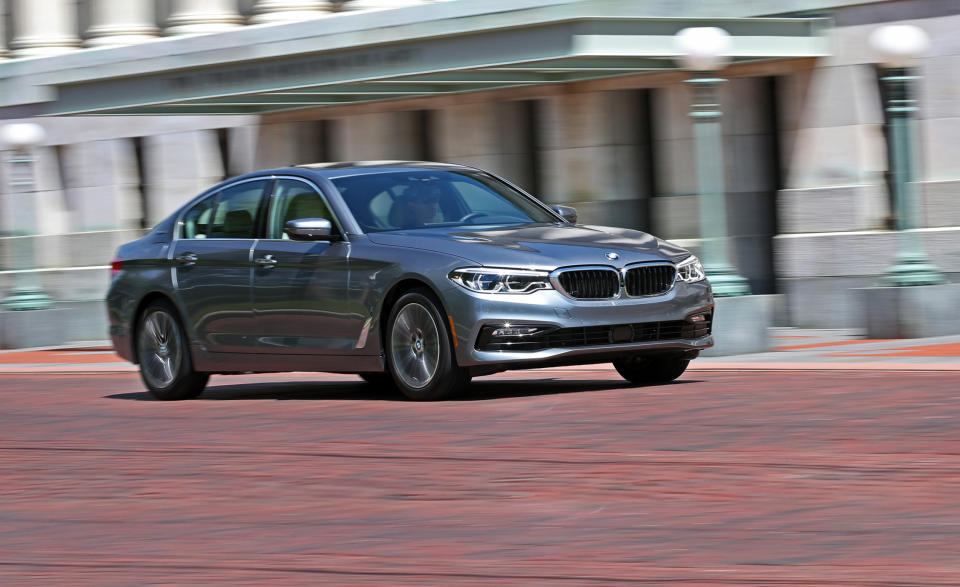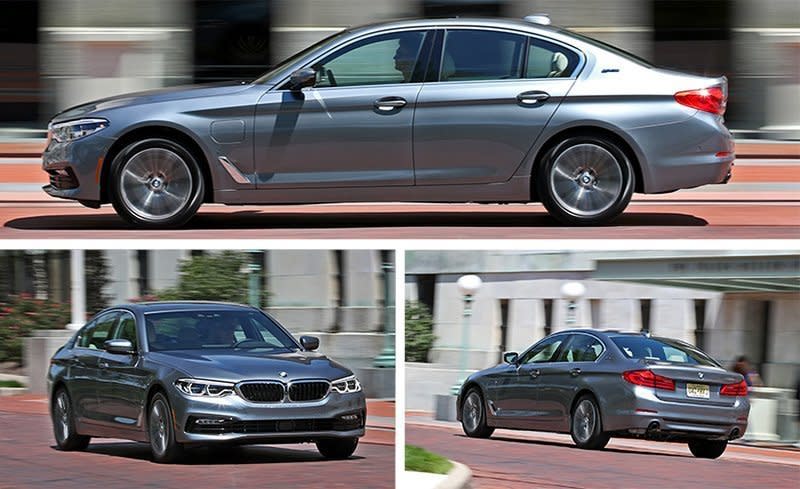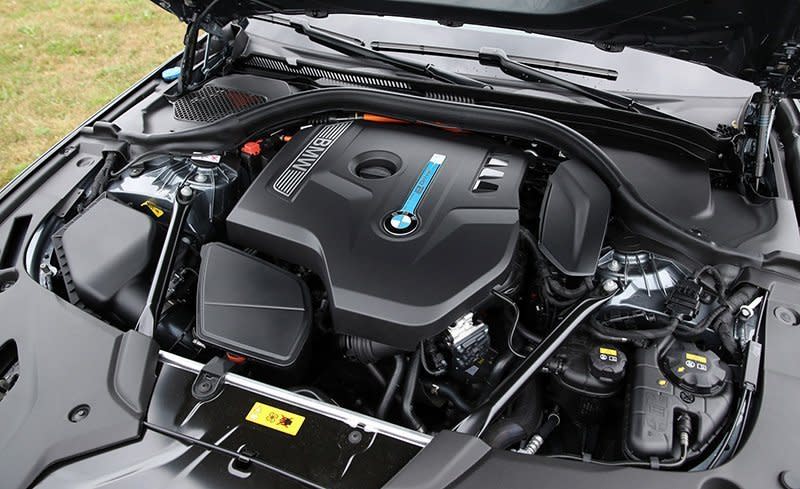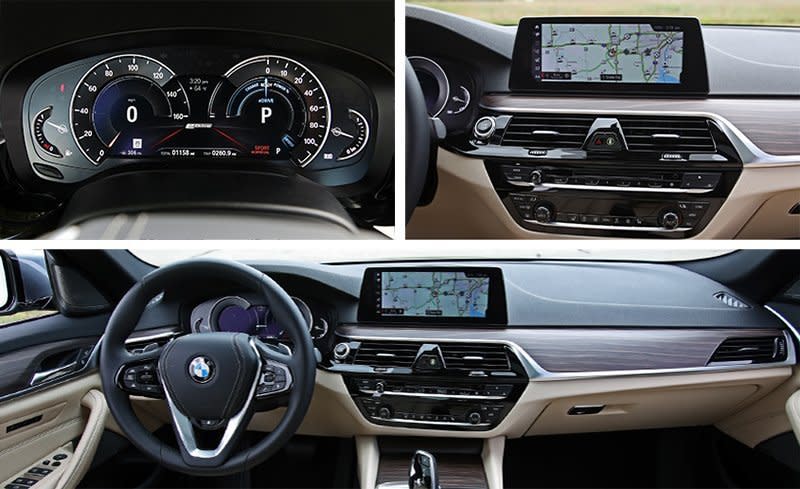2018 BMW 530e xDrive Plug-In Hybrid

The quiet operation and up to 15 miles of electric-only driving range provided by the 530e’s eDrive plug-in powertrain complement the latest 5-series’s focus on luxury. A 9.2-kWh lithium-ion battery stuffed under the trunk floor powers a 111-hp electric motor/generator positioned between the engine and transmission. These components are shared with the smaller 330e, larger 740e, and taller X5 xDrive40e. The 530e’s 180-hp turbocharged 2.0-liter inline-four shares specifications with the 330e; BMW’s other iPerformance plug-ins use more powerful four-bangers.
Gas and Electric
Total output is identical to the four-cylinder, nonhybrid 530i’s 248 horsepower, though torque is up a substantial 52 lb-ft to 310. The extra urge offsets this all-wheel-drive model’s extra weight. Our test car reached 60 mph in the same 6.1 seconds as a 429-pound-lighter, all-wheel-drive 530i xDrive we recently tested. In normal operation, the electric motor (which replaces the eight-speed automatic transmission’s torque converter) blends nicely with the turbocharged engine to provide effortless thrust, particularly when pulling away from a stop.

Aside from relatively sluggish high-speed acceleration—hey, the thing’s heavy—the plug-in 5-series has virtually no downside. It costs exactly the same as the gas-only 530i. Its EPA-estimated 15-mile electric-only driving range may be low by modern plug-in standards, easily beaten by the far less expensive Toyota Prius Prime, the plug-in Cadillac CT6, and the Chevrolet Volt, but that is 15 miles of electric-only driving you can’t get in a normal 530i. Even if you don’t splurge on a 240-volt connection for the home garage, plugging the 530e into a standard 120-volt wall outlet easily tops off the battery overnight. BMW says charging the pack from its fully depleted to fully charged state takes seven hours on 120 volts and less than three when using a 240-volt source.
As with all plug-in hybrids, the 530e’s efficiency depends on how it’s used. We notched a so-so 30 MPGe (miles per gallon equivalent) over 1000 miles. That number could have been higher had we prioritized electric-only operation, limiting trips to less than, say, 20 miles and constantly plugging in the car to maintain a full battery charge. We didn’t do that. We charged the 530e when it was convenient—mostly at our office—and otherwise drove it like a normal hybrid. On our 200-mile highway fuel-economy test, the 530e returned 39 MPGe, or 5 mpg better than the 530i xDrive.
More noteworthy is how seamlessly the technology is integrated. Because the electric motor feeds torque through the traditional automatic transmission, running through the same gears as the engine does, even in electric-only mode the driving experience feels natural. (Most smaller plug-ins use continuously variable transmissions or position the electric motors on a separate axle from the gas engine, giving the car a bi-modal feel.) Running solely on electrons, the beefy 530e moves well enough around town.

Manage Your Own Energy
Besides the Sport, Comfort, and Eco Pro driving modes, there are three settings for deploying electric power: Max eDrive, Auto eDrive, and Battery Control. In the first, the 530e operates as a pure electric up to 87 mph or until the driver pushes the accelerator pedal past the kick-down switch—essentially, to the floor—which the car registers as a call for the powertrain’s full combined efforts and fires the engine for help. When the battery’s charge is nearly depleted, the 530e reverts to regular hybrid operation. In Auto eDrive, the car sorts out when to switch to electric-only operation for brief periods for enhanced efficiency, while in Battery Control the driver can specify that the battery maintain a set charge level—so that the energy can be saved for later electric-only driving—or command that it recharge its own battery as it drives along.
Keeping tabs on these modes is no problem: BMW fits an easy-to-read analog battery charge gauge opposite the visually similar fuel gauge in the instrument cluster, something we wish more automakers would do. Between those gauges sits an analog speedometer and a digitally rendered analog power meter that, to the right of the 12 o’clock mark, displays how much electric thrust is being deployed as a percentage. (The needle moves counterclockwise when decelerating to show how much energy is being captured to recharge the battery.) Depending on the battery’s state of charge and the selected electric drive mode, the power meter also highlights—via an animated overlay—exactly how much electric thrust the driver can deploy without firing the gas engine. Simply press the accelerator until the gauge’s needle nuzzles against the top end of this visual cue to keep the engine at bay.
A separate digital meter accessible via the trip computer at the bottom of the gauge cluster condenses battery charge and miles-per-gallon data into a linear graph. The left side tracks how many miles of electric-only driving you’ve accomplished so far on that tank of fuel and lights up in a bright blue when the engine isn’t running; the right side depicts where your driving falls on a spectrum from zero to 99 mpg. The latest BMW Connected+ phone app offers even more ways to keep tabs on the 530e, including remotely checking the battery’s state of charge (you can even set charging parameters), pre-conditioning the interior, or peeking at the car’s surroundings in 3D via a remote feed from the parking cameras.

Frankly, it’s more fun to try and maximize the 530e’s use of electricity using the intuitive dashboard interface than it is to hustle it around. The steering is devoid of feel, and in Comfort mode the body wallows slightly when quickly changing directions. In lieu of any semblance of fun-to-drive, the BMW serves up a creamy ride (even with our test car’s $1000 adaptive suspension set to its firmer Sport setting) and a roomy interior that is deathly quiet. It may be capable of cornering at 0.88 g, but it sends the driver few messages that it has any interest in doing so. That the car needed 193 feet to stop from 70 mph is probably more attributable to mass, but the standard Pirelli Cinturato P7 All Season Run Flat tires aren’t exactly performance rubber. Still, that’s easily 20 feet more than we’ve come to expect from German luxury sedans in general, and fully 39 feet longer than what we measured for a Mercedes-Benz E300 4Matic riding on summer tires. An attentive driver can sense the transitions between regenerative and friction braking, but the pedal otherwise feels natural and progressive and, long distances notwithstanding, there was no fade after several repetitions of the exercise.
Although the 530e xDrive base’s $55,695 base price is identical to that of the non-PHEV 530i, our test car rang in at $69,760. More than $14,000 of that was attributable to options, including the $800 Cold Weather, $3400 Driving Assistance Plus (which includes the $1700 Driving Assistance package), $1300 Parking Assistance, $2700 Premium, and $1050 Lighting packages. Yet the car you see here merely covers the luxury-sedan essentials such as heated seats, adaptive cruise control, lane-keeping assist, and premium audio: Fiddling around with BMW’s consumer website, we configured a 530e with a sticker price just shy of $84,000. If you really need to brag that your mid-size German luxury plug-in hybrid was expensive, the 530e offers plenty of opportunity.
Specifications >
VEHICLE TYPE: front-engine, all-wheel-drive, 5-passenger, 4-door sedan
PRICE AS TESTED: $69,760 (base price: $55,695)
ENGINE TYPE: turbocharged and intercooled DOHC 16-valve 2.0-liter inline-4, 180 hp, 255 lb-ft; permanent-magnet synchronous AC motor, 111 hp, 184 lb-ft; combined output, 248 hp, 310 lb-ft; 9.2-kWh lithium-ion battery pack
TRANSMISSION: 8-speed automatic with manual shifting mode
DIMENSIONS:
Wheelbase: 117.1 in
Length: 194.6 in
Width: 73.5 in Height: 58.4 in
Passenger volume: 99 cu ft
Trunk volume: 15 cu ft
Curb weight: 4442 lb
C/D TEST RESULTS:
Zero to 60 mph: 6.1 sec
Zero to 100 mph: 15.5 sec
Zero to 120 mph: 23.7 sec
Rolling start, 5–60 mph: 6.6 sec
Top gear, 30–50 mph: 3.6 sec
Top gear, 50–70 mph: 4.5 sec
Standing ¼-mile: 14.5 sec @ 97 mph
Top speed (governor limited): 127 mph
Braking, 70–0 mph: 193 ft
Roadholding, 300-ft-dia skidpad: 0.88 g
FUEL ECONOMY:
EPA combined/city/highway: 28/27/31 mpg
EPA combined gasoline+electricity: 67 MPGe
C/D observed: 30 MPGe
C/D observed 75-mph highway driving: 39 MPGe
C/D observed highway range: 470 mi

 Yahoo Autos
Yahoo Autos 